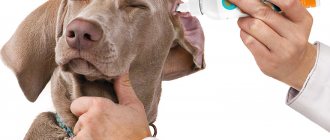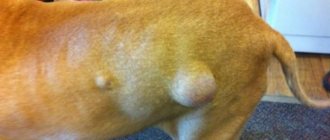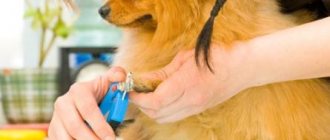Ear mite infestation
All wild and domesticated carnivores are susceptible to otodectosis . Not only canines, but also cats can get sick; moreover, cats get ear mites much more often than dogs. Ear scabies are caused by microscopic sarcoptoid mites, a favorable environment for reproduction of which is a warm, humid atmosphere. At temperatures below 5 degrees, the parasites die within a few hours without going into suspended animation.
Infection with ear scabies occurs through contact. Infection occurs not only through direct contact of a sick dog with a healthy one. The owner can easily bring ear mite eggs from the street on his hands, shoes, or clothes.
It is important to understand that a person is only a carrier. Ear mites are not parasitic on humans.
The most common carriers of otodectosis are stray animals, especially cats. Direct contact with the ear of an infected animal is not required; tiny eggs of parasites can end up on the skin or fur of an infected animal. Therefore, your pet must be carefully protected from contact with stray animals.
Tsipam
Tsipam – acaricidal-insecticidal ear drops for dogs with contact-intestinal action. The drug is a light, oily, homogeneous liquid. Packaged in polyethylene sterile dropper bottles, packed in cardboard boxes. "Tsipam" is prescribed for the treatment of otodectosis, notoedrosis, sarcoptic mange, psoroptosis, demodicosis, otitis, complicated by bacterial infections.
The active components of Tsipam help destroy ixodid and sarcoptoid mites, which provoke the development of ear scabies in dogs, cats, and other warm-blooded animals. The veterinary drug is effective against adult parasites and their larvae. “Tsipam” for dogs is also effective against fleas, ticks, and lice.
Tsipam ear drops are not recommended for use simultaneously with other pharmacological agents for external treatment. Before use, we recommend consulting with a veterinarian who will select the optimal course of treatment. There are no contraindications to the use of the veterinary drug.
Tsipam for the treatment of ear diseases of various etiologies in dogs
Main symptoms and signs of disease in a pet
Symptoms of ear mite infection in a dog (initial stage):
- Twitches his ear;
- Shakes his head;
- Constantly scratches ears with claws or rubs against corners of furniture;
- Plaque in the auricle of a dark (almost black) color;
- Inflammation, redness, swelling of the ear;
- Becomes restless, nervous, or, on the contrary, unusually melancholic.
Signs of advanced otodectosis
:
- Plaque in the auricle becomes abundant, crusts and scabs may be present;
- Unpleasant odor from the ear (with complications with otitis media);
- The animal scratches its ears until the wounds are painful;
- Decreased appetite;
- Increase or decrease in general body temperature;
- Lethargy, weak state, or vice versa, increased nervousness;
- Partial or complete hearing loss;
- It is possible to release exudate both from the ear canal and from abrasions from claws.
If you have at least one of the above symptoms, you need to carefully examine the condition of your dog’s ears. If there is a dark coating that looks like ground coffee sediment, you should immediately show the dog to a doctor. Signs to contact the clinic may include redness and swelling of the ear, and an unpleasant odor from the ear.
Methods for diagnosing otodectosis
An absolutely accurate, one hundred percent diagnosis of “otodectosis” can only be made by a qualified veterinarian . To detect ear mites, wax is collected from the ear and examined under a microscope. Only in this way can you guarantee the presence of parasites in the ear and begin treatment.
A complete diagnosis of otodectosis takes place in 3 stages:
- The dog owner's oral history of symptoms;
- Visual inspection of the auricle;
- Checking ear plaque under a microscope.
Ear scabies cannot be diagnosed at home. Sarcoptoid mites have a size of no more than 0.5 millimeters - it is almost impossible to notice them with the naked eye.
Breeds at risk
All dog breeds are susceptible to ear disease, without exception, but most often it occurs in:
- Dachshund;
- Cocker Spaniels;
- Bassetov;
- Laek;
- Toy terriers.
These breeds are at risk due to their short stature and folded ears. Their ears are so low that they sometimes drag along the ground, collecting all kinds of infections. In addition, due to poor ventilation, bacteria develop. Hunting breeds are at risk because, due to their orientation, they have to spend a lot of time in the water, helping the owner get to the game.
Treating ear mites at home
At the initial stage, otodectosis is absolutely not dangerous; treatment for the parasite cannot even be called a full-fledged treatment. Much bigger problems are caused by concomitant diseases - but this is the prerogative of only the veterinarian.
To get rid of ear mites, it is enough to treat the dog’s ear twice with insectoacaricidal agents. Treatment regimen for otodectosis at home:
- It is necessary to purchase an insectoacaricidal drug from a veterinary pharmacy;
- Clean the surface of the ear with a cotton swab from scabs and exudate;
- Treat the ear with the medicine according to the instructions;
- Massage the folded ear in half to distribute it evenly over the surface;
- After 10–14 days, repeat the procedure;
Ear parasites often have low resistance to drugs; sometimes a single treatment is enough. But to be completely sure of recovery, the procedure is still repeated.
If after repeated treatment the symptoms of otodectosis do not go away, you must immediately contact a veterinary clinic - the diagnosis may not have been made correctly.
Possible complications
Otodectosis is not as terrible as its consequences. At the initial stage, getting rid of ear mites is quick and easy, but if the parasite is left unchecked, consequences will inevitably come, perhaps even fatal. Therefore, it is very important to monitor the dog’s health and consult a doctor at the first symptoms.
Related ear mite problems:
- General decrease in immunity due to intoxication by parasites;
- Perforation of the eardrum;
- Partial or complete hearing loss;
- Allergic reaction to arachnid saliva;
- Otitis;
- Dermatitis (or even eczema);
- Inflammatory processes in the auricle due to otitis media or allergies;
- Meningitis.
- The final complication is the death of the animal due to concomitant diseases.
Treatment of complications of otodectosis is a costly and lengthy process; it is strongly not recommended to engage in therapy on your own - you can cause even more harm.
Otoferanol Gold
The veterinary preparation is intended for external use. Prescribed for dogs with otodectosis, sarcoptic mange, otitis, complicated by bacterial flora. Otoferanol Gold has a detrimental effect on ixodid and sarcoptic ticks at all stages of their development. Available in 10 ml bottles.
Ear drops are low-toxic, safe veterinary drugs of the new generation. The active components included in the drug have anti-inflammatory, regenerating, antimicrobial, fungicidal effects, accelerate the healing of wounds, ulcers, microcracks, and promote the restoration of cellular structures in damaged tissues. Five drops are injected into each ear of large dogs and three drops of decorative and small breeds with an interval of seven days.
Medications
Modern veterinary medicine offers a wide selection of insectoacaricidal drugs in various release forms. A huge range of products are highly effective due to the low resistance of ear mites to active substances.
In the initial stage, it is necessary to stop the cause - to destroy the parasite. If otodectosis has not started and concomitant diseases have not developed, then additional funds will not be required.
Before using any medications, prior consultation with a veterinarian is necessary. Complications or individual intolerance to the drug are possible.
Drops in the ears
Drops against ear mites:
- Surolan
. It is used to treat the consequences of otodectosis (allergic reactions, inflammation). It is not an insectoacaricide. Directions for use: 3-5 drops in each ear for two weeks. Price: 15 ml – 920 rubles, 30 ml – 1400 rubles. - Oricin
. Effective insectoacaricide. Additionally, it has an anesthetic and antipruritic effect. Directions for use: 2 to 5 drops in each ear (the exact dosage is prescribed by the veterinarian depending on the weight of the dog) for a week. Price: 535 rubles. - Bars
. The drops have an insectoacaricidal effect, also additionally relieves inflammation and kills gram-positive bacteria. Apply 3 to 5 drops twice (depending on weight) with an interval of 10 to 14 days. Price: 150 – 200 rubles. - Otoferonol gold
. It has no additional properties other than fighting ear mites; it works exclusively against the parasite. Apply twice with an interval of 2 weeks, 3-5 drops in each ear. Price: 80 – 90 rubles per 10 ml.
Ointments
Options for ointments against otodecosis:
- Aversectin ointment
. Insectoacaricidal drug. Does not have anti-inflammatory or antipruritic properties. Works only against the parasite. To treat ear mites, the ointment is placed in the auricle twice with an interval of 10 to 14 days (at the rate of 0.3 grams per square centimeter). Price: 90 – 100 rubles per 30 grams. - Sulfur-tar ointment
. A complex remedy against parasites, it also has antimicrobial and disinfectant properties. Apply for 7 – 10 days, rubbing a thin layer into the ear. No previous removal of hair or scabs is required. Price: about 30 rubles per package.
Aerosol foams
Aerosols and sprays against ear scabies:
- Acaromectin
. The insectoacaricidal drug, which is highly effective, has no additional properties. It is used at the initial stage of otodectosis. Method of use: the spray is used twice with an interval of 2 weeks, sprayed onto the inside of the ear. Price: 150 rubles for 15 ml. - Anti-fly spray
. It is used to prevent infection by parasites and to destroy those that have already settled. It does not have antiallergic and anti-inflammatory properties, and is not suitable for the treatment of otitis media. Application: apply the spray to the inner surface of the ear, distribute over the entire surface, repeat the treatment after 7 - 10 days. Price: about 800 rubles.
Injections (shots)
The most effective injections against otodectosis:
- Aversect 0.5%. Not recommended for use in combination with other antiparasitic agents. It has a wide spectrum of action against ectoparasites, including ear mites. Apply subcutaneously or intramuscularly 2 times with an interval of 10 - 14 days at the rate of 0.2 mg per 1 kg of dog weight. Price: 90 rubles for 5 ml.
- Ivermek 1%. An effective remedy against sarcoptic mites. It is used as an antiacaricidal agent subcutaneously or intramuscularly at the rate of 0.2 ml per 10 kg of dog's live weight. Repeated administration is recommended after 10–14 days. Price: 55 rubles for 10 ml.
- Otodectin. Has a wide spectrum of action against ectoparasites. Ear mites have low resistance to the drug. Apply subcutaneously at the rate of 0.2 ml per 1 kg of dog weight. Re-treatment after 2 weeks is recommended. Price: 70 rubles for 10 ml.
Drops on the withers
Effective drops on the withers against ear mites:
- Frontline spot it
. Insectoacaricidal agent, contact action. Method of use: the product is instilled into each ear, 3 to 5 drops, depending on the weight of the dog, the rest of the bottle is applied to the withers. Price: 480 – 640 rubles depending on the volume of the pipette. - Advocate.
Used as a treatment and prevention of otodectosis and other ectoparasites and also helminths. Apply every 28 days, applying to the dog’s withers. Price: 1700 – 2600 rubles depending on the weight of the animal.
Drops on the withers are used mainly as prophylaxis against ectoparasites, or in the initial stages of otodectosis.
Otodepin
Veterinarians prescribe the hygienic ear drug “Otodepin” to animals for the effective treatment of external and internal otitis of various etiologies, as well as in the treatment of ulcers and hematomas. It is a light yellow transparent liquid of oily consistency with a pleasant pine odor. Packaged in sterile bottles of 10 ml. Otological veterinary medicine is also used for prophylactic purposes, to prevent the development of fungal and infectious diseases of the ears. Before use, the drops must be warmed to room temperature.
Otodepine contains pine essential oil, saponins, and mullein extract. The drug has a wound-healing, antimicrobial, antiseptic, deodorizing, and tonic effect. Eliminates inflammatory processes, improves metabolism in cellular structures, accelerates the healing of wounds and ulcers, and improves tissue trophism.
Otodepin for dogs
Otodepine does not have a sensitizing or toxic effect. Does not cause allergies. The drug is absolutely safe, low-toxic for dogs, regardless of their breed or age. It is acceptable to use for treatment and for preventive purposes in small puppies from three weeks of age. Side effects are noted in extremely rare cases and only in case of individual intolerance to the active components. Before use, carefully read the instructions for the veterinary drug.
Treatment with traditional methods
Traditional methods of therapy are not an effective method of treatment. It is most effective as a preventive measure or as an adjuvant.
If there are a large number of dried crusts and scabs in the ear, you can use oils (camphor, coconut, etc.). Apply with a cotton pad to soften and further remove crusts.
- You can use strong green tea (no sugar!) as an antiseptic. Prevents the development of infections and kills the unfavorable bacterial environment in the ear canal. Green tea lotions should be done twice a day for 10 to 14 days.
- To disinfect and prevent the development of infection (especially if the dog scratches the ear, injuring it), you can use chlorhexidine or hydrogen peroxide. The treatment is carried out with a cotton swab dipped in the solution, 2 times a day, until the dog is completely recovered.
Prevention of otodectosis in domestic dogs
As you know, any disease is easier to prevent than to treat. By following basic preventive measures, the dog will remain healthy and long, costly and troublesome treatment will be avoided.
Ear mite prevention measures:
- The most effective way to prevent otodectosis is regular treatment with insectoacaricidal agents. It is necessary to use anti-ear mite products from early spring (as soon as the snow melts) until late autumn (before frost).
- Prevention should be carried out regularly throughout the season. You should not delay treating your pet even for a few days, especially if the dog actively communicates on the street with its fellow tribesmen.
- If for some reason the animal is not treated, it is prohibited to allow it to interact with other dogs (especially stray cats).
- The owner must follow the rules of hygiene - wash his hands after going outside, before petting the pet; Don't let your dog lick your shoes.











